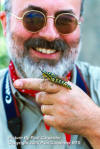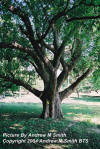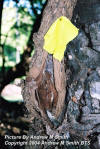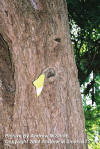| The
Hanumavilasum
Tiger Spider Sanctuary
by Andrew M Smith (Chairman)
Some
of you are aware, that myself and Paul Carpenter have just returned
from a three week fieldtrip to India, where we have not only found
a new Poecilotheria spider but have also located the most important
Poecilotheria colony, which has been discovered to date.
The site, which is made up of 1000 mature trees and covers an area
of 60 acres, is absolutely astonishing and although for reasons of
security I cannot reveal to you the regions location or at present
give too many details, I have included in this first report a welter
of photographs. These are, of course intended to wet your appetite
and give you some idea of the scale and importance of our find and
possibly the moral forces, which now motivate our actions. You will
also of course observe that the photographs are simply scrumptious,
and may want to take this opportunity to reflect on the probable transient
nature of a site, where every second tree has a spider and every third
tree has two spiders.
The colony is of such scientific importance that both myself and Paul
immediately concluded that we would make every effort to have the
site registered as a micro habitat - worthy of our very best conservation
efforts - and explore the possibility of having the site recognised
as the worlds first Tiger Spider Sanctuary.
On returning home in December, the pair of us kicked off the Tiger
Spider conservation project by presenting it to the Committee of the
BTS, with the recommendation that this was a project worthy of our
Societies full support. The BTS Committee overwhelmingly endorsed
the project and gave me a full mandate to approach a number of senior
and worthy conservation bodies in India and the UK, with a proposal
to try to establish the Hanumavilasum Tiger Spider Sanctuary. The
day's business having been concluded, the Committee then broke up
with the heady task before them of developing a number of practical
fund raising projects - to be discussed at the next BTS meeting in
February. If this project kicks off, we are going to need to raise
a large sum of money - quickly.
As a Scientific Fellow of the Zoological Society of London, I of course
first approached ZSL for advice in developing both a project proposal
and to sound out their views on the feasibility of this project. To
put it bluntly, a project may sound great, but if the great and the
good deem it to be pie in the sky then it is inevitable that it will
be given a " no response from Beagle".
Thank goodness, Paul Pierce-Kelly's response at ZSL has been a most
warm and generous one and I am now in the process of drawing up a
formal proposal. Should the proposal be accepted by ZSL, we will then
seek further UK backing and a sympathetic senior partner amongst the
Indian conservation groups. It will of course be this body, which
will have before it the challenging task of both advising the funding
raising groups and negotiating a working proposal with both the sites
existing landowners and the local community. This is the nuts and
bolts of conservation and will only work if both the landowners and
the local community are empowered - firstly by the knowledge of the
sites importance and secondly by being given the resources to protect
a unique and valuable world class micro habitat. They must also be
given access to professional advise on how their wonderful ecological
creation can be sympathetically developed in perpetuity, ensuring
both the future of the site as an important local commercial resource
- and from our point of view, as a secure habitat for what is a gravely
endangered spider.
It is a challenging project and I would be most eager to hear what
the membership of the BTS has to say on the matter. For myself, I
believe that this is a project, which the Society can not only get
its teeth into and become a force for good, but also to grow - not
just in membership, but also in spirit. We are the oldest Tarantula
Society in the world - and drawing upon the resources of our large
international membership, have led the way with practically every
new innovation in the hobby. This has ranged from not only instigating
both the first captive breeding programmes in the mid 1980s and a
world class Tarantula Website in the 1990s - but also hosting both
Europe's largest annual Tarantula Exhibition and the February Hilton
Hotel Arachnid Lectures. All of this and of course a colour Journal,
which in the next issue has even more colour! Now my dear readers,
do we just tread water and remain content to do nothing or do we seek
a new challenge in the establishment of the world's first Tarantula
Sanctuary. In doing so, we will all recognise in each and every one
of us, the intrinsic truth that we have all fed greedily from nature's
trough and now is the moment for atonement - to seek redress and do
good. To paraphrase a Kennedy - ask not what this hobby can do for
you, but what you can do for the hobby.
Ironically the spider chosen for this project, Poecilotheria has been
the emblem of our Society from our earliest days and although it is
not recognised as such yet, it is considerably more endangered than
Brachypelma and very worthy of our deepest esteem.
But what do you think? You are our membership. It is you who we will
be coming to in the near future when the money has to be raised. With
out your unstinting support, we will fail.
For those of you who want to hear and see more, I will of course be
talking about this project in my talk at the BTS Hilton Hotel lectures
- Saturday 28th February. I will also be giving you a series of updates,
which will appear in our Publicity Officer, Carl Portman's new column
on the BTS website. As for the spider, it will be described in the
next BTS Journal and although I had initially intended to call it
after my friend Peter Kirk, Peter has insisted that this is not appropriate
and that it should be called Poecilotheria hanumavilasum after the
name of the religious site on which it was found. The spider then,
from its very inception into the world of modern science, is still
bound by its name to the ancient community and to the local deity
of the sanctuary in which it has survived. At this point I should
add that two specimens were collected as type material and the holotype
will be deposited in the Calcutta Zoological Survey collection.
If you have got time, turn up for the lectures - the slides are the
best ever taken in the field and I assure you that Paul Carpenter
and myself have shot off more than a few hundred rolls of film over
a decade of travel and research. This is our fifth field trip to India
and Sri Lanka in search of Poecilotheria - and in all of that time
and over two decades of travel in Africa, America and the Far East,
I have never seen a tarantula colony - so rich in these magnificent
spiders. We did of course richly abuse this opportunity by carrying
out a three day, one acre survey of the site - which, with the able
assistance of my south Indian researcher Jackin Jayaram, included
drawing and photographing every tree and noting its occupants. We
shot off over 30 rolls of film between us over that short period of
time and I estimate that I have thrown away only 10 dud photographs.
We had a bean feast and Ganesh, my adopted Indian god of obstacles
beamed down on our venture from high and of course was placated, with
the smashing of two coconuts.
At which point I can hear you say - Andy how is the Poeci book coming
along? And my reply would be that I am, as is Peter with his chapters,
burning the midnight oil. It is a richer, more thoroughly researched
project than I have ever undertaken - which includes a huge body of
field and archive research. Much of the information has never been
seen before - which is what you expect of my books, but as many of
our American friends at the ATS lectures last year will testify, we
have managed to introduce a new dimension into the story of the Tiger
Spider. This has been done, by telling the story of the spider from
the perspective of the Collectors and the Arachnologist's. This has
of course, taken many months of additional genealogical research,
which has included tracking down the families involved and securing
new unpublished photographs. We now have some astonishing, 100 year
old family images of Reginald Pocock and the key collector, Mr. H.
R. P. Carter - culled from family albums. It has also meant employing
Indian and Sri Lankan researchers, who have spent the last two years
tracking through the forests of India and Sri Lanka, in order to secure
additional folklore, distribution data and field photographs. All
of this and a pledge by my Publisher that the book will contain one
hundred colour photographs. The title has also been finalised.
Poecilotheria Tarantulas
& The Tiger Spider Wallahs
My
Publisher assures me that this title is all to do with websites and
search engines.
Should the BTS proposal find favour with both ZSL and the Indian Organisation,
which we have in mind we will then begin the serious task of raising
funds. The site will need a boundary fence, a local caretaker and
outside Indian expertise and guidance on securing the future of the
site and the spider. We have already entered into negotiation with
a UK based Conservation Trust and next year we will actively seek
the support of other Tarantula Societies. From the BTS membership,
we will need additional fundraising ideas - other than the obvious
one of asking you up front for cash. By the way - no cash yet please,
until Peter has sorted out our new Charity Status. Have a think and
ask yourself, are you associated with any fundraising groups and conservation
bodies that would want to support the first ever Spider Sanctuary?
We estimate, having surveyed one acre that the site contains in the
region of 600 to 800 Poecilotheria spiders. The first ever, accessible
arboreal tarantula colony that is ripe for first class research and
in the years to come, we hope will be visited by organised groups
of enthusiasts - who will take nothing but photographs and leave nothing
but footprints.
Please, can I ask you to send your messages of support or voices of
dissent to the BTS website. Not me - or I will never find time to
write another word again and at the moment I am doing a punishing
12 hour day on the keyboard. Voice your views and let us hear what
you have to say.
Andrew M Smith - Chairman
To view any of the pictures at full scale click on the thumbnail
versions

Andrew Smith and
colourful little friend


The 60-acre site has 1000 numbered trees, most of which are over 80
years old. The site is owned by a Hindu temple trust.


Scattered
amongst these groves of old trees - are small sacred sites dedicated
to the local family deity, Muneeshwarankovil.
On one tree we were astonished to discover a Poecilotheria spider
in a silk tube retreat - behaving rather like an arboreal, new world
Avicularia. Dash it, Poecilotheria spiders live in deep holes, not
silk tubes!! Other silk tubes were also discovered and at present
we believe that this is the first recorded instance of a Poecilotheria
spider having been found in such a retreat. It was also from such
a retreat that we extracted the type specimen of what will be described
in the next BTS Journal as Poecilotheria hanumavilasum.





Mark Carpenter examines the type specimen before it was drawn and
dissected.
The four of us then began to undertake a one-acre survey of the site,
which essentially involved pacing the distance between each tree and
then marking them out on graph paper. Each tree was then examined
and if occupied, marked with a small yellow flag. We then photographed
and drew each tree and retreat, noting if the spider was an adult
or juvenile.

Jackin Jayaram examines a likely broken branch for a Tiger Spider.





Paul Carpenter scours each and every tree, fixing yellow flags to
any holes, which display the telltale strands of silk that indicate
occupancy.

 
A very rare daytime shot of a Poecilotheria in its retreat.
Much work can be during the day, but it is at dusk when the Tiger
Spider slowly emerges from its lair, eager to feed on the geckos that
crouch in the folds of the trees bark - that the real photography
begins.
   
  
The photographs are of a single spider, chosen in random from the
16 individuals that we photographed during the research period - many
of whom will be shown to a lucky few at the February lecture. We will
also use further images to update the site and of course in the forthcoming
book.
Update – March 2004.
He spider has now been formally described in the BTS Journal as
Poecilotheria hanumavilasumica. In order that as many people as possible
can read about the history pertaining to this theraphosid before its
rediscovery we have decided to reproduce the original BTS article from
Journal No 2 - volume 19.
Update – March 2007.
I cannot believe that three years has passed since Paul Carpenter and
myself stood under that black Indian sky, surrounded by the shadowy
outlines of tamarind trees and shone our torches on spider after spider
as we searched the boughs above our heads. At some point we must have
touched the face of the forest god himself - for in that unique glade we
were inspired to dream of preserving the immediate area as a
micro-sanctuary. For three exhilarating and exhausting days – and nights
- we had surveyed the richest Poecilotheria site, the pair of us had
ever seen and as we sat on a log and I fired up my pipe – we were
overwhelmed by a terrible bleakness and fear that what we had
experienced was only illusionary. I have not been back and although my
friend, Thurston Kroes has been to the vicinity and collected this
spider for captive breeding - he only fleetingly visited the site and
thus, I cannot tell you how the plantation and the spider colony have
fared. The region, you will remember, was also torn asunder in the
tsunami and it is likely that many of the fishermen and plantation
workers that I interviewed are now dead. One is further left with a
strong impression of the unsettling arbitrariness of fate, by the fact
that in the year when the wave struck, I had just left Sri Lanka. The
devastation was to include the hotel and the staff, where only days
before – outside of Hambantota - I had said farewell to my IUCN team.
Thus does the fickle finger of fate decide our lives!
When we returned to the UK, Paul Pierce-Kelly generously agreed to fund
a site survey with the assistance of the renowned Indian conservation
group, Zoo Outreach. Various meeting were arranged and I was asked to
draw up a proposal for funding, which I dully did. Ironically the very
day that I arranged to meet the instigator of this organisation, BTS
officer, Ray Hale had informed me that a second zoo in Kent had also
agreed to become associated with the project. Nevertheless the fates
that govern the destiny of a project were to decide otherwise and I was
gently informed that day, that due to the politics that govern the world
of Indian conservation – no Indian organisation could be found that
wanted to be associated with the BTS. Which, of course, is one of the
ironies of life, in that there is no conservation lobbyist or hobbyist
organisation on earth that has contributed more to the captive breeding
and the knowledge of these spiders (over twenty years) than the BTS –
and yet still we are a hobbyist organisation and as such are despised by
many professional wildlife and conservation bodies. To paraphrase the
words of one particular figure - we do not want to be associated with
the ‘blood money that is at the heart of any hobby or organisation that
is linked to the wholesale collection, marketing and keeping of
tarantula spiders’. My protests that this view was false and that the
BTS does not condone mass collecting for the pet trade and only supports
captive breeding and the small-scale collection of specific species, by
collector/breeders - as you can imagine - fell on death ears.
Unfortunately, like it or not, in the eyes of most researchers in the
world of wildlife law enforcement and conservation, the keeping of
tarantula spiders is viewed as just another face of the trade in wild
animals – and although we are not on a par with the trade in reptiles
and parrots, we are still not kosher. Not good, I am afraid, and I
suspect that it will not improve until we are seen to police our own
hobby and discourage the last importation of large numbers of wild
caught spiders. To put it bluntly, in this day and age, we do not need
to be associated with the gross injustice associated with wholesale
collecting for the pet trade. In fact, I would argue that the continued
live trade in large numbers of Grammostola rosea - primarily shipped in
for the pet-shop trade – can now only be defined as scandalous. The only
collecting of wild caught spiders that we should condone are the small
numbers needed for captive breeding – anything else is unnecessary.
The last thing that I heard about the Hanumavilasum tamarind plantation
and temple site, was that its importance as a scientific site had been
picked up by a leading Indian conservation group and that they were
exploring the idea of allowing an established, Hindu temple trust in
Calcutta to take the plantation under its wing. It would seem that this
particular religious trust has been associated with natural history
conservation projects for many centuries and it was thus felt that it
would be appropriate for this body to offer guidance to the guardians of
the Hanumavilasum temple site. All one can do is keep ones fingers cross
and hope that the local god Muneeshwarankovil has enough influence to
preserve this sacred site - which is probably immune to change in the
short term. In the long term, the picture is somewhat darker as these
local deities and temple sites slide into gentle decline, when the young
people of the region leave for work in the cities and the regional
villages become retreats for the old, the infirm and the least
motivated. I suspect that when the last old villager is placed upon his
funeral pyre, Muneeshwarankovil will ascend to the heavens with his
ashes and then the poor will come and log the plantation for firewood.
Thus will be the fates that decide the future of this particular
Poecilotheria hanumavilasumica colony.
It may interest the reader at this point, to know that the BTS are very
aware of the PR implications behind the problems that have arisen
concerning the development of this project and are tackling the issue of
how the hobby is negatively perceived by a number of conservation
bodies. One of the first things that we have done is establish the
annual BTS Overseas Research Grant, which is for the princely sum of
£500 (approx. $900) and is intended to support and fund the work of
researchers – on the Theraphosidae and Scorpionidae, in developing
countries. We are thus putting our money where our mouth is and linking
the resources of the BTS to research projects that increase our
understanding of these beautiful spiders and, at the same time, our
standing in the scientific community. We are also launching at the end
of this year a discussion document - aimed at both our membership and
the hobby at large – called, An Agenda For Change. The intention is to
examine the hobby as a whole and then introduce a programme of
initiatives, which it is intended will seize the moral high ground from
the various organisations and individuals who purport to speak with
authority on the subject of the conservation of theraphosid spiders. In
future, we intend that it will be the BTS, (in liaison, with other like
minded tarantula societies) which will be there to offer funding and
encourage the publication of independent, hard-hitting regional faunal
surveys, taxonomic and behavioural studies – by local researchers. We
intend that it will be the BTS, with its huge body of published papers
and articles (dating back over twenty years) which, will be seen to be
the primary resource and the first port of call of any organisation that
is seeking information on the trade, husbandry and captive breeding of
theraphosid spiders.
We also promise you that if the membership draws our attention to any
unsavoury aspects of the hobby, which are in need of examination – then
we will not shirk from our responsibility in calling for an open debate
and discussing the issues in public. Many of our membership, for
instance, who have passed through overseas airport gift shops, have been
shocked to see for sale hundreds of cases of dried tarantula spiders and
other exotic fauna. We are now, very aware of how the collection of this
material is associated with our hobby and we intend to launch a public
debate and, if it is your wish - initiate a campaign to stamp out this
disgusting trade. We are still examining our researchers reports but we
are swiftly coming to the conclusion that outside of the orbit of
habitat destruction, it is this trade, which is directly responsible for
the decline in many of the theraphosid colonies that we have monitored
in the Far East. Even more alarming, our field researchers have observed
large numbers of South American species being set in display boxes in
Malaysia, which would indicate that this ghastly trade reaches out much
further than the Cameron Highlands. At this point, I should point out
that for many decades the boxed butterflies have been captive bred in
both Malaysia and Costa Rica – but that is not the case for spiders.
They have been pillaged from their habitat sites, killed by spiking or
by placing them in plastic bags in the sun and then shipped by the
thousand to companies in the Far East, who relax, set and box them for
sale in tourist outlets. So, the next time that you are told, you and
the pet trade are responsible for the decline in tarantula numbers in
the wild – spit in their eye. It is these buggers who have done
irreparable damage to a number of tarantula colonies and it is we who
have been blamed. In our discussion document – An Agenda For Change,
this is one of the many areas that we wish to profile and throw into the
arena for debate. If dried spiders are to be boxed, as part of an
economic programme that aids local workers in the third world, then
those spiders should be the product of an indigenous captive breeding
programme – not wild caught.
If you are a tarantula enthusiast and are not a member of the BTS, then
join us in our work to protect and develop our understanding of these
wonderful spiders. We are the most professional of all of the hobbyist
organisations and for your membership fee you will receive a quarterly,
full colour Journal, access to the BTS Exhibition and the opportunity to
attend the BTS February lectures – which are the key social event for
many enthusiasts and where you can meet up for a weekend of lectures,
good food, beer and bonhomie. The event is now so popular that members
fly in from all over Europe and the United States to attend. We are also
beginning to draw up discussion plans for an additional weekend of
taxonomy workshops and further bonhomie in 2008 – all of which makes the
BTS a society that is well worth joining.
We are a society that encourages healthy debate - that respects the view
of others - and listens to and champions the views of its members. Many
of you will have also noticed on the Internet that we have an active
policy of discouraging discord and destructive flame wars. We also have
a transparent financial and administrative system (an AGM and published
accounts)) and a large committee that meets, face-to-face, three times a
year. We strive to empower the hobbyists and arachnoculturist’s who join
us, with access to the cutting edge of husbandry and captive breeding
literature – written by many of the leading names in both arachnoculture
and the larger world of theraphosid research. As the chairman of this
society, I would say to all of you - by all means support, cherish and
work for your local national societies - but if you want to make a
difference, then join the BTS. Tarantula spiders are global - as are the
problems that they face - and only the BTS has the resources and the
infrastructure to reach out, over the next decade, mobilise its
international membership and endeavour to champion noble causes. We also
have a strict policy of supporting and treating with all other tarantula
societies, websites and independent journals on an equal footing – based
on respect and co-operation. We do not do destructive schism – we intend
to do unity and noble causes.
And if we don’t – then others will champion them in our stead, and those
others may not look kindly upon arachnoculture and take the opportunity
to sweep us away with those who would abuse and exploit them. At present
most wildlife and conservation bodies, view hobbyist’s organisations,
such as ours with grave suspicion. If we are to work together then it is
going to have to be one of mutual respect - and respect has to be
earned.
Andrew M Smith - Chairman
Note - The copyright of all of the spider sanctuary images, which
are displayed, are owned by Andrew Smith and Paul Carpenter. They
may not be used unless permission has been obtained from the copyright
holders.
 |